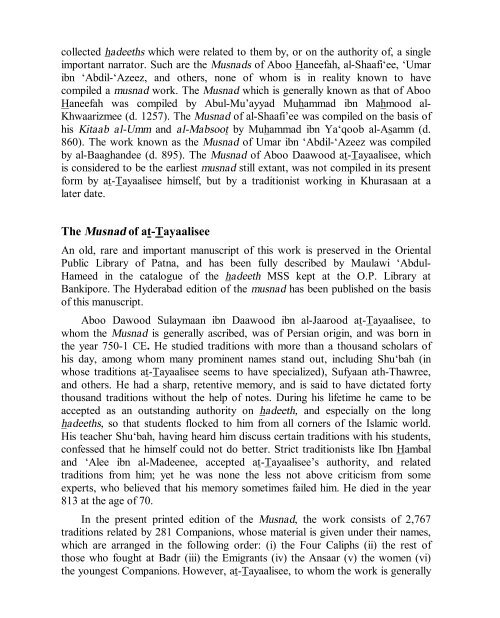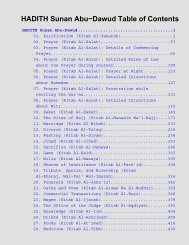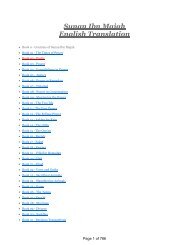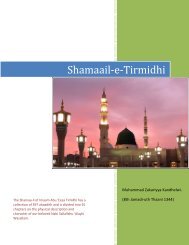Create successful ePaper yourself
Turn your PDF publications into a flip-book with our unique Google optimized e-Paper software.
collected hadeeths which were related to them by, or on the authority of, a singleimportant narrator. Such are the Musnads of Aboo Haneefah, <strong>al</strong>-Shaafi‘ee, ‘Umaribn ‘Abdil-‘Azeez, and others, none of whom is in re<strong>al</strong>ity known to havecompiled a musnad work. The Musnad which is gener<strong>al</strong>ly known as that of AbooHaneefah was compiled by Abul-Mu’ayyad Muhammad ibn Mahmood <strong>al</strong>-Khwaarizmee (d. 1257). The Musnad of <strong>al</strong>-Shaafi’ee was compiled on the basis ofhis Kitaab <strong>al</strong>-Umm and <strong>al</strong>-Mabsoot by Muhammad ibn Ya‘qoob <strong>al</strong>-Asamm (d.860). The work known as the Musnad of Umar ibn ‘Abdil-‘Azeez was compiledby <strong>al</strong>-Baaghandee (d. 895). The Musnad of Aboo Daawood at-Taya<strong>al</strong>isee, whichis considered to be the earliest musnad still extant, was not compiled in its presentform by at-Taya<strong>al</strong>isee himself, but by a traditionist working in Khurasaan at <strong>al</strong>ater date.The Musnad of at-Taya<strong>al</strong>iseeAn old, rare and important manuscript of this work is preserved in the Orient<strong>al</strong>Public Library of Patna, and has been fully described by Maulawi ‘Abdul-Hameed in the cat<strong>al</strong>ogue of the hadeeth MSS kept at the O.P. Library atBankipore. The Hyderabad edition of the musnad has been published on the basisof this manuscript.Aboo Dawood Sulaymaan ibn Daawood ibn <strong>al</strong>-Jaarood at-Taya<strong>al</strong>isee, towhom the Musnad is gener<strong>al</strong>ly ascribed, was of Persian origin, and was born inthe year 750-1 CE. He studied traditions with more than a thousand scholars ofhis day, among whom many prominent names stand out, including Shu‘bah (inwhose traditions at-Taya<strong>al</strong>isee seems to have speci<strong>al</strong>ized), Sufyaan ath-Thawree,and others. He had a sharp, retentive memory, and is said to have dictated fortythousand traditions without the help of notes. During his lifetime he came to beaccepted as an outstanding authority on hadeeth, and especi<strong>al</strong>ly on the longhadeeths, so that students flocked to him from <strong>al</strong>l corners of the <strong>Islam</strong>ic world.His teacher Shu‘bah, having heard him discuss certain traditions with his students,confessed that he himself could not do better. Strict traditionists like Ibn Hamb<strong>al</strong>and ‘Alee ibn <strong>al</strong>-Madeenee, accepted at-Taya<strong>al</strong>isee’s authority, and relatedtraditions from him; yet he was none the less not above criticism from someexperts, who believed that his memory sometimes failed him. He died in the year813 at the age of 70.In the present printed edition of the Musnad, the work consists of 2,767traditions related by 281 Companions, whose materi<strong>al</strong> is given under their names,which are arranged in the following order: (i) the Four C<strong>al</strong>iphs (ii) the rest ofthose who fought at Badr (iii) the Emigrants (iv) the Ansaar (v) the women (vi)the youngest Companions. However, at-Taya<strong>al</strong>isee, to whom the work is gener<strong>al</strong>ly





